What is the name of a sweater with a high collar? What is the difference between a men's jumper and a pullover? Wearing rules
In this article we will tell you the difference between a jumper and a pullover and how to wear them correctly.
Jumper(from the English jumper - jumper) is a sports sweater with a round collar, without a collar or with a collar of various shapes.
Pullover(from the English pull over - pull from above) is a knitted garment put on over the head, with a V-shaped neckline.
Initially, the jumper was created as warm clothing for athletes, but after WW2 it entered the everyday wardrobe of men and women. home distinctive feature a pullover jumper has a round neckline, while a pullover has a wedge-shaped neckline English letter V. The absence of a collar is also a feature of a pullover, although you can notice that in online stores they do not make much distinction between these wardrobe items.
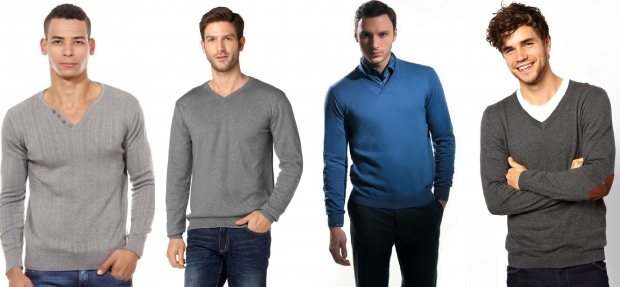
Modern models jumpers assume the presence of a collar, and the options are very diverse. Here it is worth mentioning the differences between a sweater and a jumper. The latter has a zipper or button closure, while the sweater has a close-fitting collar without fasteners. The most common models of jumpers are:
1) with crew-neck. This is a classic round neckline that completely opens the neck. The most popular model of jumpers, combined with a shirt or T-shirt. A product made of fine yarn is worn under a jacket.

2) with polo collar. This is a turn-down collar and has a placket with a zipper or buttons. Has a pronounced sporty style.

3) with stand-up collar. The collar sometimes reaches the earlobe, so the model is suitable for tall men with long neck. Visually, the pullover style shortens the neck and adds volume to it. A stand-up collar can be the choice for thin, lanky young men who lack muscle mass.
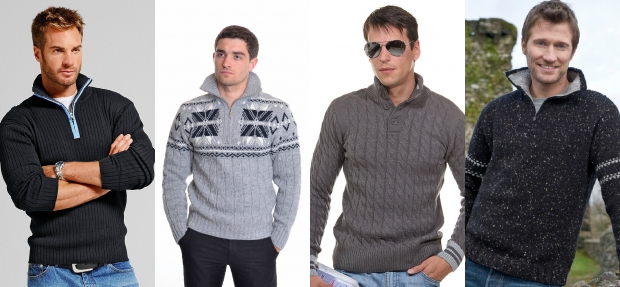
4) with shawl collar. This is a transitional option between a shawl and a polo. Suitable for everyone without exception. The shawl is used on products made from thick, warm yarn.
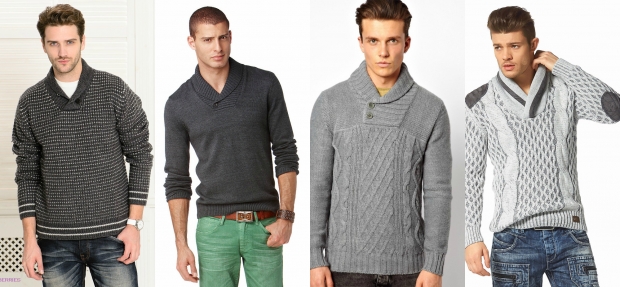
5) with a hood. A sports version of jumpers. The hood has a stylistic effect, but in cool days and during sports it is thrown over the head. Used as an independent item instead of a windbreaker.
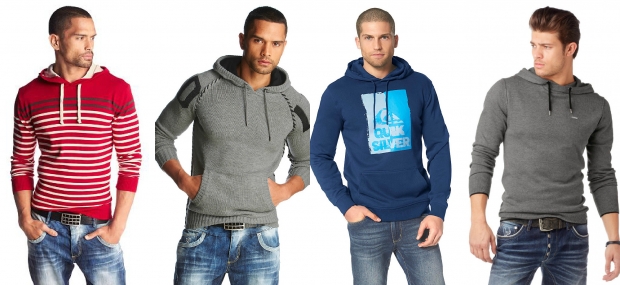
Models pullovers somewhat less due to the fact that they are characterized exclusively by a V-shaped neckline. Therefore, there are two most common models:
1) with a classic V-neck. Combine with a T-shirt, shirt, worn untucked or tucked into trousers. It depends on the situation: an untucked shirt suggests an informal style, tucked into trousers - an option for work or school. Sometimes pullovers are worn over a naked body or over an alcoholic T-shirt.

2) with a hood. It differs from a jumper in its wedge-shaped neckline, although externally it is difficult to distinguish them.
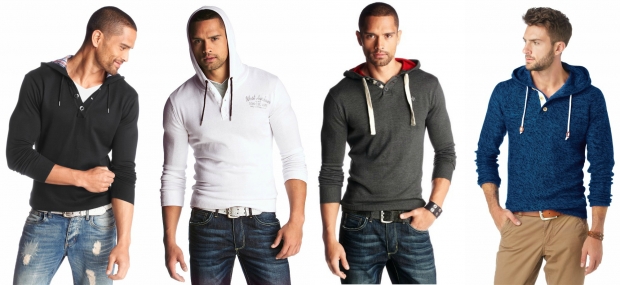
The rules for what to wear with jumpers and pullovers are the same in both cases. These are versatile pieces of clothing that go with almost all types of clothing.
1. With jeans. This is the most popular tandem that every man has in his wardrobe. A simple combination, unremarkable. Ideal for students and employees when there is no strict dress code at work.
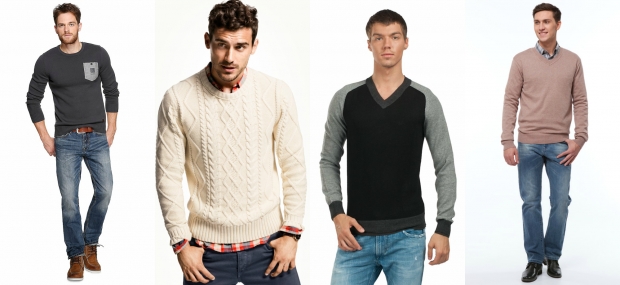
2. With trousers. Change from jeans to classic trousers - and you're a different person appearance. This combination always looks elegant.
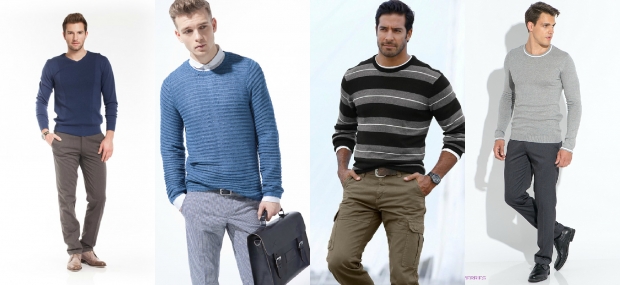
3. Under the jacket. Sweaters and pullovers made of fine fiber fit well, so they can be worn under jackets. In the cold season, such a duo will replace a raincoat or windbreaker.

4. With shorts. In summer or late spring, when the sun has already sufficiently warmed the air, a cotton or viscose pullover can be worn with shorts and sneakers or shoes. Please remember that ankle length socks are not recommended.
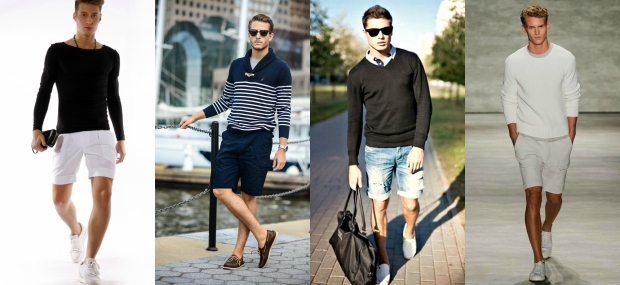
5. Free style. Don't forget about the sporting purpose of clothing. Jumpers look good even with sweatpants.

As for shoes, the only thing that should be excluded are sandals and flip-flops. Considering the democratic direction of outerwear, it is worn with sneakers and sneakers. The combination of shoes and a matching jumper looks stylish and elegant. White and black sneakers are a universal option. You can wear colored laces with jeans.
A more mature and balanced option is considered classic shoes. Black shoes are not suitable; they go better with suit options. Terracotta, brown, beige and colored shoes - the variety of sweaters and pullovers offers a wide field for creativity.
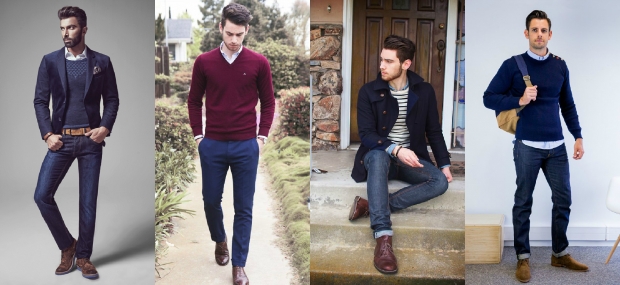
Men's fashion does not stand still, and designers suggest wearing long sweaters and jumpers with... leggings. Once upon a time, this controversial item of men's wardrobe was more popular than trousers, but now only the most progressive and self-confident men will dare to wear it. If you decide to do this, remember that the pullover should reach mid-thigh.
I suggest you look into it and find out a lot of interesting things for you!
T-shirt. Z
A T-shirt is an item of clothing, usually without buttons, collar or pockets, with short sleeves that covers the torso.
The T-shirt is put on over the head. Her sleeves usually reach mid-shoulder.
T-shirt with long sleeves.(pictured is a short sleeve T-shirt and a long sleeve T-shirt)
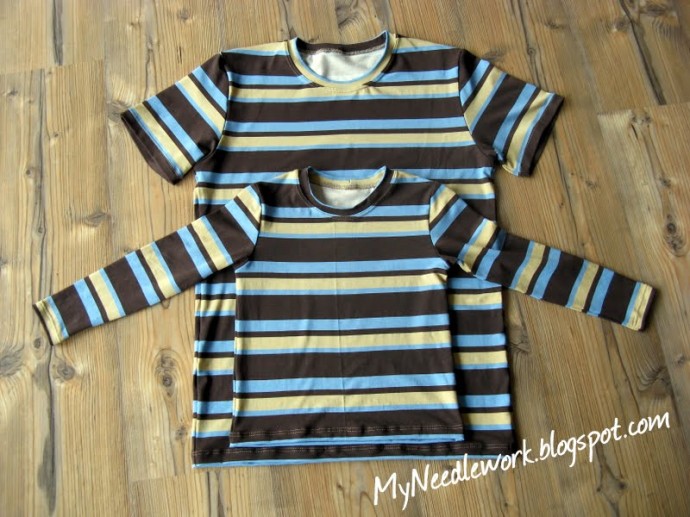
As the name suggests, it’s the same T-shirt, only it has long sleeves :)
The borrowed word is longsleeve.
Here is a link I found this description:
Longsleeve is a borrowed word and translated from English means long - long, sleeve - sleeve, and all together - a long-sleeved T-shirt.
The term itself refers to clothing that resembles a T-shirt, but with long sleeves. It could be training clothes, underwear, which is worn under a shirt in winter, etc.
They also say about T-shirts with long sleeves - Sweatshirt, but as I understand it, not every T-shirt with long sleeves can be called a sweatshirt.. But the term sweatshirt is present in the GOST classification.. that’s why we often find labels with the word sweatshirt, which is a little funny now for us :)

Turtleneck (banlon, beatlovka, golf) - a thin, tight-fitting sweater with a collar that covers the neck. The name comes from the fact that this item of clothing was worn by divers under a diving suit.
In the 1960-1980s, the word “banlon” (as well as the distorted “badlon” and “bodlon”) was also used dialectically, presumably derived from the name of the brand of polyamide synthetic fiber Bonlon.
It can have a knitted or knitted texture and is used as both casual and festive wear.
A jacket is a piece of woolen knitted clothing for the upper body with a fastener from bottom to top in the front. The jacket became the basis for the appearance of other items of shoulder knitted clothing - sweaters, pullovers, jumpers, jackets. It is worth noting that even if a jacket has a high, buttoned collar, it is more correct to call it a jacket rather than a sweater.
Blouse(from the French Blouson - jacket) - women's light clothing made of thin fabric in the form of a short, fitted shirt. The blouse contains sleeves, collar and cuffs. It is often fastened with buttons, but there are also tunic-like blouses.
Blouse- a loose shirt worn without a belt. Clothes for both men and women.
Kangaroo. Kangaroo
Kangaroo is a type of sweatshirt that has a hood and a large patch pocket. This type of clothing received its name by analogy with Australian marsupials, which carry their young in special pockets. These types of clothing are worn over the head and do not have fasteners.
IN Lately The following products have become popular: hoodies, sweatshirts, bomber jackets. All these are also types of sweatshirts.
Sweatshirt– a sweatshirt without zippers or straps with a pocket at stomach level.
You can read more about the sweatshirt.
Initially, a sweatshirt was part of a sports uniform; athletes wore it before and after training, as well as during breaks between them. The purpose of the sweatshirt was to absorb sweat and prevent the body from getting too cold.
Some interesting things :)
The first sweatshirts were made from special knitwear produced on a circular knitting machine (loopwheel cotton). Such machines worked very slowly and produced only a meter of fabric per hour. But due to the fact that the cotton threads were not subjected to unnecessary tension, the fabric was very soft, thick and durable, and the item did not shrink after washing, as was the case with the first sweatshirts. You can still find perfectly preserved sweatshirts made in the 40s to 60s in the USA. Most of those machines have long been written off, but some companies are still trying to produce sweatshirts using old technologies, mainly in Japan.
Under the collar line in the center there is a triangle, which is formed by two seams intersecting each other. Now it is purely decorative, but previously a lining of corrugated material was inserted into the area of this triangle so that the sweat flowing from the neck would not wet the entire sweatshirt, but would be absorbed into this triangle. Also main feature The sweatshirt has a round neckline. Sweatshirts can have pockets (welt or kangaroo), as well as a hood.
Hoodie is an elongated jacket with a hood. The hoodie is slightly longer than standard sweatshirts - usually its length is about 70 cm (it slightly covers the hips).
Material from Wikipedia - the free encyclopedia.
A hoodie (English hoodie, from the English hood - “hood”) is an analogue of a sweatshirt (sweatshirt) made of soft cotton jersey, with an anorak hood (having a front stand that protects from the wind). Characteristic elements are large front patch pockets and a hood.
Bomber is a sweatshirt with a zipper and a stand-up collar.
I managed to find this one interesting information(See details here)
Rugby jackets
Indeed, college students often wore American college jackets embroidered with the rugby team they supported and, by extension, their home university.
College jackets, whether men's or women's, have the same style. A distinctive feature of this type of clothing: the sleeves are usually made in one color, and the bomber sweatshirt itself is made in another. The college jacket is also distinguished by a clasp in the form of metal buttons and the presence of pockets. Inscriptions with university logos on American sweatshirts were originally made using embroidery, but now other options for applying images are available: for example, printing using thermal film. The bomber sweatshirt with a letter on the chest has become something of a classic. Classic option A red or blue rugby jacket with gray sleeves is considered.
A few more definitions, but right now they’re not as popular as long sleeves and hoodies :)
Olympian
One source on the Internet gives this definition:
Olympic jacket - a sports jacket with a zipper with a short stand-up collar and ribbed cuffs. Made mainly from synthetic materials.
The Olympic jersey was created as part of a tracksuit. Olympic athletes wore it over their T-shirts and then dramatically took it off before a game or performance.
The first tracksuits with an Olympic jersey were worn by the Soviet team at Olympic Games in 1952. The Olympic shorts were woolen, blue and with large white felt letters “USSR”, and the zipper ended in the middle of the chest.
You can see a little more interesting stuff here
In the West, these sports jackets became relevant in the 90s of the last century, thanks to football fans who wanted to imitate their idols in everything.
Trowel.
The same as the Olympic jersey :). Here's an interesting observation. An olympic jacket is called a trowel in some regions, and it is interesting that the “trowel” and the “olympic jacket” clearly do not have clear geographical boundaries and it is not entirely clear what determined the dominance of one or another name in a particular area.
When shopping for clothes in stores and reading the inscriptions on the price tags, we notice that seemingly identical things have different names.
Jumper and pullover
Jumper, pullover, sweater, cardigan... What are the differences? similar friend on other things? Let's take a closer look at the pullover and jumper. A jumper is an item of knitted or knitted clothing with a round collar. Pullover is a woolen or knitted product. So what's the difference between them? The difference is in the shape of the collar, which is round for the jumper, and V-shaped for the pullover. Both items of clothing are worn by both women and men. The jumper does not have buttons or other fasteners.
The name of the pullover comes from the English pull over, literally “put it over the head.” Until the beginning of the twentieth century it was purely sportswear, which tennis players or golfers loved to wear. The lack of fasteners made it very comfortable. The word "jumper" was also formed from English word jumper, which means jumper. This clothing was also intended for sports; it was worn by track and field athletes. Today, pullovers and jumpers are worn by absolutely everyone, regardless of gender, age and occupation.
It should be noted that at the beginning of the twentieth century, pullovers were considered exclusively the privilege of the stronger sex. The famous Coco Chanel, who loved to introduce elements into women's wardrobes, eliminated unfair discrimination men's clothing. It was she who gave the pullover flirty and elegant notes. The result was not long in coming, and soon the pullover became very popular. Pullovers and jumpers are made from a variety of materials: polyester, wool, cotton, viscose, acrylic. But no matter what fabric they are made from, these wardrobe items are suitable for almost all seasons. And this makes them very popular and in demand.
Sweater
The jacket is a knitted garment with a fastener: zipper or buttons. It is she who is the basis from which all other outerwear. The jacket was also worn by the ancient Egyptians. It acquired its heating function in Europe, in the 18th century. Irish and Scottish sailors wore the jacket. The jacket can easily be confused with a cardigan. A clear division of such clothing appeared not so long ago. Previously, all things with a button fastener were called a jacket. A sweater may have a stand-up collar, a wide collar or not have one at all.
Cardigan and sweater looks
A cardigan is a type of cardigan and has a button closure that runs from the front from bottom to top. This item of clothing got its name from its creator, Earl Cardigan, who invented insulated clothing with buttons as a uniform. Knitted cardigans are very popular today among both men and women. They are worn with jeans, trousers and even chiffon dresses.
The classic cardigan has a full-length fastener, a V-neck, and no collar. Depending on the type of knitting and yarn, the product has different thickness and volume. Options can be either fitted or loose, length from the waist to mid-calf. Traditional colors wool - brown, beige, black, dark blue, mustard and gray. Modern cardigans may be far from classic. These are sewn, knitted, have a hood and collar, light and warm, voluminous and tight-fitting models.
A sweater is a knitted garment with a high collar without a fastener. The name comes from the English word “sweater”, which means “to sweat”. A sweater, unlike a cardigan and sweater, which can also be knitted, was initially always only knitted from wool and decorated with various ornaments, relief patterns, and braids.
Sweatshirt and sweatshirt
A sweatshirt is a wide and long shirt (blouse), which got its name thanks to famous writer L.N. Tolstoy. At one time, the sweatshirt received recognition from the writer’s fans. Today, these clothes have undergone great changes; their main purpose is to keep warm. A sweatshirt can be called both a vest and a product with a sleeve. It can be with a hood, with a zipper, etc. It is widespread among young people, and is especially loved by athletes: cyclists, skateboarders, rollerbladers.
Something between a sweatshirt and a sweater is a sweatshirt. It is sewn from knitted fabric. The sweatshirt has a round neckline, a loose fit, and does not have a fastener. Models are decorated with drawings, prints, logos of sports teams and educational institutions. After their appearance, sweatshirts immediately became quite popular among athletes. Today, this item of clothing has firmly entered the everyday wardrobe, becoming almost basic. Sweatshirts decorated with sprint patterns look good combined with feminine items such as pumps or lace skirts. So, it is quite possible to understand this fashionable terminology, despite the apparent external similarity. After all, each thing has its own distinctive feature, and when buying another model, you definitely need to know its name.
Mikhail Vorontsov













